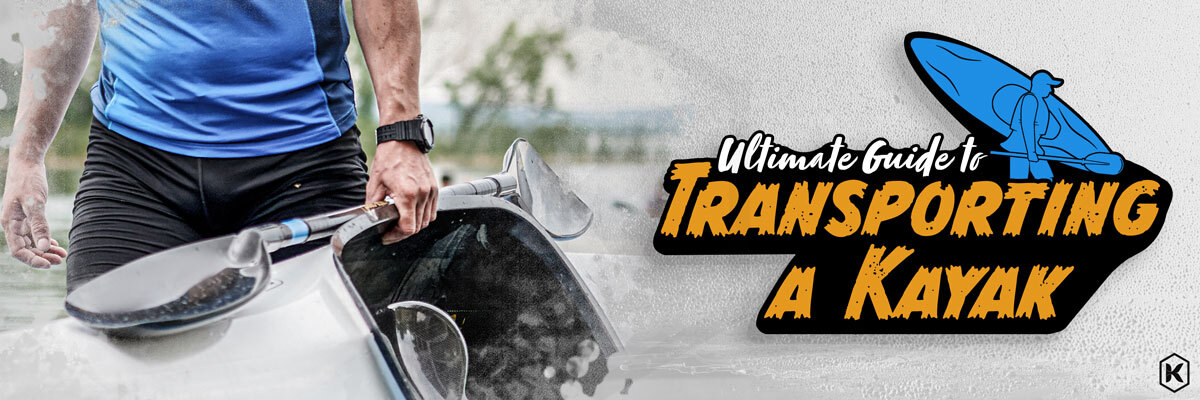Ultimate Guide to Transporting a Kayak

Kayaking is an excellent way to get outside and explore all that nature has to offer. However, many people are stuck with how do you carry a kayak to the water? The most convenient method is to use a set of good quality roof racks. There are a set of roof racks for any vehicle, even if you don't have any anchor points!
A pair of roof racks will generally come in two types hard rails or soft rails. Hard rail racks are suited to vehicles with dedicated anchor points, but these are usually specifically designed for your vehicle. You can buy these as aftermarket units or factory-installed for the perfect fit. When you use hard racks, you may prefer to buy a roof rack mount or J-style carrier to make loading and securing your kayak easier. If you have hard rails, it is beneficial to use additional padding to protect your kayak.
If you're after versatility, then a set of soft roof racks are ideal. Soft roof racks can be made from rubber, inflatable tubes, or neoprene. Soft roof racks can be installed on any vehicle, and they are quick to set up, remove, and store.
Transporting your kayak is a vital part of any kayaking trip. Completing the trip should be safe and convenient for everyone. While you may find the first few times to be a little daunting, after heading out a few times, you'll be a pro, and you'll have the loading and unloading down to a fine art.
We've included some of our top tips in this blog if you're starting with kayaking or need to brush up on some skills. If you have any additional questions about transporting your kayak, please call our local team for some advice.
Get your vehicle ready to transport your kayak
Kayaks are often very long, with most models being two metres long. Kayaks (or plastic boats) of this size are often too large to fit inside most vehicles, except for vans and some Utes. The best way to get a kayak from your home to the water is with a set of roof racks.
You should install your roof rack system before you get your kayak out from storage. You can start with the roof rack between the rear doors and then between the front doors. Make sure everything is tight and secured well according to the manufacturer's instructions. After all, there is little point in getting the kayaks secured to your racks if the racks are not attached to the car properly!
For a breakdown of the types of kayak rack available and which is best suited to your vehicle, you can read through our other blog post.
Using a roof rack to transport your kayak
After you've got your roof racks installed and ready to go, it's time to load your kayak. The easiest method of loading is with a two-person lift. Align the kayak next to your vehicle, and then each person can take hold of the kayak and lift it straight onto the roof racks.
Depending on your mounting gear, you can place the kayak upright or upside down. Then it would be best if you centred the kayak, so it is balanced properly. After you've loaded the first kayak, you can lift the second kayak into position (if you're taking more than one).
Once the kayak is in position, you can tie up any loose ends and strap it down with two suitable straps. If you're using soft roof racks, these may have straps already in place, and you can tighten these up. You can run a strap underneath your kayaks with hard racks and then secure it to the rear crossbar and then the front crossbar. When tying down your kayak, ensure they are safely secure and tight enough for any long-distance travel.
Loading a kayak without assistance
If you're loading a kayak alone, you may benefit from using a kayak loading system. Lifting a kayak can be challenging for most people, especially after a hard day on the water. Getting the kayak onto your car roof is easier with a purpose-built kayak loader. These will provide an added lift to make the job a breeze. For tall vehicles (4WD, vans, etc.), you can use the side loader, and for sedans and station wagons, you may find the showboat or rack and roll system provides enough lift.
Securing your kayak onto roof racks
If you're driving for long periods, you want to ensure your kayak is secured correctly. The bow and stern lines must be taught and secured to their anchor points. If you have two kayaks on your roof rack system, you can tie these directly to the crossbars and then use an additional strap to tie them to each other. If you're concerned about the cam buckle and straps rubbing on your kayak, then you can use pool noodles cut down one side and slide over the strap for protection.
After you've tied down your kayaks, check that nothing shifts around, and then you're good to head off. Ideally, you want to stop at least once per hour to check all your straps and ensure everything is still holding correctly.
Keeping your kayak secure with bow and stern lines
Bow and stern straps provide additional stability to your kayak while on your kayak racks. You can use cam straps to secure these, but dedicated bow straps and stern straps are often more suited to the job. These two straps will include attaching the lines to your hood and boot.
When you're tightening the stern straps, you don't want to pull them too tight, as this may lift the front of your kayak. Get both lines firm but not overly tight. These straps installed lets you secure one kayak or more efficiently and safely.
Driving safely with your kayak loaded
When your kayak is loaded, and the car is all packed, it can be easy to forget the kayaks are on your roof. Before you head off, measure the height of your vehicle, especially if your kayak carrier is holding a second kayak. In addition to the extra height, your car may weigh more than usual, so check on your tyre pressure, and give yourself extra distance from the car in front of you.
During longer trips, such as weekends away, you may need to stop often and check that the stern straps and bow straps are still taut and that any excess strap is securely tied down. It's always handy to have a second strap in your vehicle in case you break one while you're away from home. While checking your straps often may seem over the top, it is better to arrive a little later than to deal with a kayak flying off your car!
FAQ for carrying kayaks
Transporting a kayak with roof racks
Can I carry a kayak on my roof rack?
Yes, most roof rack systems are suited for carrying a kayak. If you have an old pair of roof racks, you may need to check everything to ensure it is secure. Factory-installed crossbars on most newer vehicles are secure enough for kayak transportation, and you may need some extra anchor straps for added protection.
Can you use ratchet straps to tie down a kayak?
Ratchet straps are a good option for securing a kayak directly to your roof racks. Ensure the kayak is balanced between the front and rear doors and correct weight distribution. When tying the ratchet, make sure you don’t apply too much pressure.
Do you need bow and stern tie-downs for kayaks?
Bow and stern tie-downs provide additional stability to your kayaks while they are on your roof racks. They may not be necessary for some short kayaks, but for your protection, bow and stern straps are highly recommended.
How do you put a kayak on a roof rack by yourself?
Lifting a kayak onto roof racks can be challenging for some people. However, you can lift the kayak from its centre point and get it up onto the roof racks with some lightweight kayaks. If you're loading a kayak by yourself, the Yakima loading systems from Kayaks2Fish are an excellent addition to your kit.
How do you attach a kayak to a roof rack?
Many roof racks are available for carrying kayaks (including factory crossbars); the exact method for tying a kayak down will differ for each type. However, to securely hold your kayaks, you'll attach at least two middle straps and then bow and stern lines to a secure point.
What is traveller soft roof racks?
Traveller soft roof racks are a brand of soft roof racks that can be installed on any vehicle that has no anchor points for a traditional set of roof racks. These will attach to your vehicle through the front and rear doors, and they usually have inbuilt main straps to secure your kayaks.
Transporting a kayak without roof racks
Can you transport a kayak without a roof rack?
It's not ideal to place a kayak on your bare roof without a set of racks. Doing this will damage both your vehicle and your kayaks. If you have a Ute, van, or station wagon, it may be possible to place your kayak in your vehicle.
How much does it cost to ship a kayak?
If you're staying at a holiday home and you don't want to take it there yourself, you can pay to have it shipped there. If you're buying a kayak from Kayaks2Fish, these can be shipped to your address, and your delivery charge will be calculated based on your address.
How far can a kayak hang out of a truck?
Anything more than a third of the total length of your kayak can be safe to hang out of a truck. However, it is best to check with the rules and restrictions of your state. To keep them safe from other drivers, you may need to attach a flag to the end of your kayak.
Operating straps for your kayak
How do you tie down a kayak with a rope?
You can tie a kayak down using ropes using a trucker's hitch. This hitch knot uses loops and turns and is well known for providing suitable tension when tying downloads. When using this knot, be sure you don't overtighten the rope.
What kind of tie-down straps are suitable for tying a kayak to roof racks?
Most ratchet tie-downs are suited for securing a kayak to a roof rack system. These straps will safely secure your kayak for the entire journey. However, it is recommended to check on the straps about once per hour of driving.
What size straps for a kayak?
As kayaks are not very heavy, you can use a standard strap width (25mm). If you're concerned about possible damage, you can use a thicker strap to distribute the pressure over a larger surface area.
Where to buy the best kayak transporting options
At Kayaks2Fish, we have an excellent range of kayak transport options in our online shop. You'll find the best kayak roof racks, and these are ideal for transporting kayaks from your home to the water. You'll also find other roof rack accessories, including ratchet tie-down straps, bow and stern tie-down, and crossbar pads.
When choosing the main straps for transporting a kayak, you need to get the highest quality available. Our Sea to Summit tie-downs with silicon covers on the cam buckles is ideal for the middle of your kayak. The silicone covering the cams will protect your vehicle and your kayak from possible damage during transport.
If you have an aftermarket roof rack system or factory-installed racks, then you may still need to use soft crossbar pads to give your kayak a safe ride from home to the water. For people carrying multiple kayaks, you may benefit from adding extra straps around the bow and stern to keep your kayaks secure.
If you're not sure which roof rack system is best for your vehicle, you can call our team, and we'll offer our recommendation. Our staff are highly experienced and can suggest that it will help you get your kayak in the water in the safest manner possible. In addition to calling, you can also send through an email enquiry, and we'll get back to you as soon as possible.










